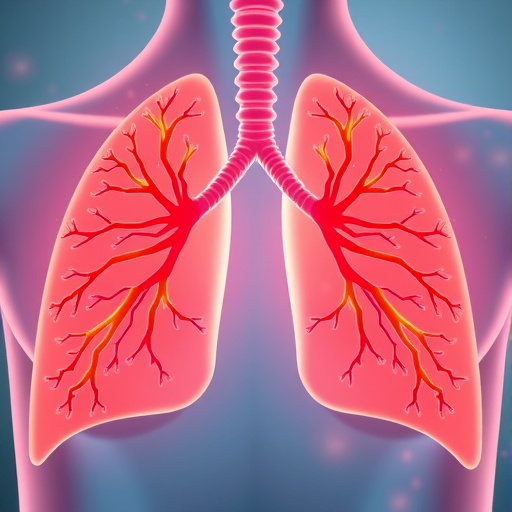University of Texas at Dallas researchers have unveiled an innovative biosensor technology that fuses advancing artificial intelligence with breath analysis to potentially revolutionize lung cancer detection. This groundbreaking approach focuses on the identification of volatile organic compounds (VOCs) in exhaled breath, which serve as potential biomarkers for various thoracic cancers, including lung and esophageal cancers. The integration of AI allows for sophisticated analysis of the biochemical characteristics of these compounds, offering a promising avenue for early cancer detection.
Dr. Shalini Prasad, a leading researcher and professor in the bioengineering department at UT Dallas, emphasized the breakthrough potential of this technology, stating that it may enable clinicians to detect lung cancer during its initial, more treatable stages. The research aims to establish a quick, affordable, and noninvasive screening tool that utilizes breath analysis, which could significantly improve patient outcomes and aid in the timely management of thoracic cancers.
Notably, the electrochemical biosensor developed by the research team is capable of detecting eight specific VOCs associated with thoracic cancers. After testing this device on breath samples from 67 patients—including 30 with biopsy-confirmed thoracic cancer—the researchers achieved an impressive success rate of accurately identifying the VOCs in 90% of confirmed cancer cases. This high level of accuracy demonstrates the potential efficacy of using breath analysis as a diagnostic tool in cancer screening.
The origins of this project closely align with global health challenges raised during the COVID-19 pandemic. At that time, there was an urgent need to explore noninvasive technologies that could assist in the rapid screening and isolation of virus transmission. Dr. Prasad noted that leveraging breath analysis was compelling due to the connection between respiratory metabolites and potential indicators of disease, showcasing the clinically relevant insights derived from human breath.
The proposed technology falls within the emerging field of breathomics—a discipline focusing on the analysis of compounds present in exhaled breath to diagnose diseases and monitor various health conditions. The significant variation in metabolites in breath can signal early disease onset, positioning this research, particularly when augmented by AI, as a vital complementary approach to traditional diagnostic methodologies.
Artificial intelligence plays an integral role within the framework of this research, as Dr. Prasad highlighted the complex data produced by breath analysis. The challenge lies in discerning which data points are clinically significant and which are not. Machine learning algorithms contribute to this filtering process, emphasizing the importance of interdisciplinary collaboration with computer science experts to develop effective analytical models that enhance diagnostic capabilities.
Collaboration was a cornerstone of this research endeavor, as Dr. Prasad worked alongside Dr. Ovidiu Daescu, a computer science expert who assisted in refining the machine learning models and validating the technological approach. The interdisciplinary teamwork harnesses the strengths of bioengineering and computational methodologies, ensuring that the developed breath profiling device is robust and ready for clinical application.
The implications of such a device are promising, with the potential to transform cancer detection practices in the medical field. Early detection of lung cancer remains a critical concern, as it stands as the leading cause of cancer-related mortality both in the U.S. and globally. By utilizing minimally invasive technologies such as breath-analysis, the research team aims to institute methods for early detection of thoracic malignancies while minimizing the patient burden associated with traditional diagnostic procedures.
Looking ahead, Dr. Prasad expressed the team’s commitment to further advancing the technology, specifically seeking more extensive clinical validation. She envisions a future where routine breath tests could be integrated into standard primary care visits, alongside traditional blood tests, allowing healthcare providers to offer proactive recommendations based on patients’ breath biomarker profiles.
This push towards making breath analysis a mainstream diagnostic tool encapsulates an ethos of leveraging cutting-edge research to enhance patient care—transforming how diseases are detected and monitored in everyday healthcare settings. By moving beyond traditional methodologies, this research signifies a critical step toward integrating innovative technologies within clinical practices.
Key contributions to this research project were also made by doctoral student Nikini Subawickrama, first author Dr. Anirban Paul, and several other scholars from both UT Dallas and the UT Southwestern Medical Center. Their collective efforts affirm the significant collaboration required to pioneer new biomedical technologies that can reshape the landscape of disease diagnosis and patient management.
As research in this field continues to evolve, the potential for electrochemical breath profiling—especially when coupled with artificial intelligence—offers a forward-thinking approach to cancer detection that bridges technological innovation with pressing healthcare needs. Continued exploration and validation of these methods could lead to more effective screening options, ultimately saving lives through timely diagnosis and intervention.
This groundbreaking development not only holds promise for lung cancer detection but could also extend to other health conditions, emphasizing the versatility and potential impact of breath analysis research. As scientists continue to unlock the secrets of breathomics, we stand at the threshold of a new era in disease detection and management, driven by the confluence of engineering, computer science, and medicine.
Subject of Research: Biosensor technology for cancer detection
Article Title: Electrochemical breath profiling for early thoracic malignancy screening
News Publication Date: 1-Aug-2025
Web References: DOI
References: Sensing and Bio-Sensing Research
Image Credits: University of Texas at Dallas
Keywords
Bioengineering, Health and medicine, Cancer, Lung cancer, Artificial intelligence, Machine learning, Breath analysis, Biosensors.




